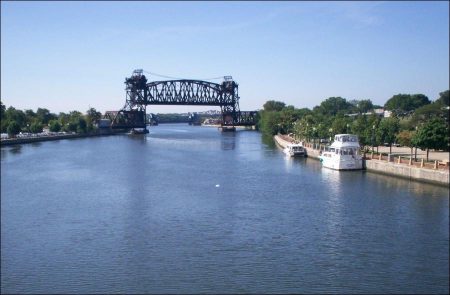Joliet (607 alt., 145,800 pop.), the seat of Will County, lies 35 miles southwest of Chicago, on the Des Plaines River and the Illinois and Michigan Canal, a part of the Great Lakes to Gulf Waterway. Here the outer belt freight lines shunt much of the through freight around Chicago.
Concerned with its freight handling and possessed of early transportation advantages, Joliet has developed as a selfdependent unit; here one senses little or no dependence upon the metropolis looming a scant hour’s drive to the northeast. Joliet reveals its economic independence from almost every approach, in railway yards, warehouses, shipping platforms, quarries, factory stacks, and mountains of coal.
This is the Joliet of which Sandburg wrote, years ago:
On the one hand the steel works
On the other hand the penitentiary.
Santa Fe trains and Alton trains
Between smokestacks on the west
And gray walls on the east…
But this is not all of Joliet; the man-of-the-street scarcely gives a thought to the penitentiary, so little does it intrude upon the life of the’ town. Across the north side of town stretches the Joliet park system, which, although planned too late to include areas in the city proper, is one of the finest among the small cities of the State. If the average resident were asked what is the most outstanding thing about his town, he would probably say the high school band, followed by the park system, and mention the penitentiary as an afterthought.
The first settler here was Charles Reed, who came in 1831. The following year he, along with numerous settlers in the vicinity, fled the region when the Black Hawk War broke out, but before the war was over they returned, and by 1834 a town was laid out and the first public sale of lots was held. By some unexplained quirk, the town was known as Juliet for years, and a nearby village romantically took the name of Romeo. When Will County was laid out in 1836, the designated county seat was referred to under the name of Shakespeare’s heroine, and a year later it was incorporated with that name.
For ten years the fortunes of Joliet rose and fell as work went forward or languished on the canal. The first boat arrived here April 11, 1848, and was met by the entire population, with bands, booming cannon, and much oratory. With its new transportation means, Joliet entered into its first industrial era, based on the large-scale shipping of local limestone. In the fifties and sixties Joliet shipped blocks as far as New York, and its quarries provided the Middle West with material for such public structures as the Rock Island Arsenal, the Indiana penitentiary, and the State House and Lincoln monument at Springfield.
The first railroad, the Rock Island, came here in 1852, followed by five other lines. Although the railroad was eventually to cause the decline of the canal it brought, in the seventies, the new industry of steel manufacture, which was further attracted by the soft coal in the vicinity. The earliest mill manufactured spikes, track bolts, and other railroad items. Bessemer plants, rail and rod mills, blast furnaces followed, and then plants that made galvanized wire, barbed wire, nails, and other products for the growing agricultural west.
In 1894 Joliet pioneered notably in the elimination of grade crossings, seeking to require the railroads to elevate their tracks in the major portion of the city. In and out of courts the battle was fought, with the lines objecting strenuously to the ordinance that had been passed. Finally, in 1904, a compromise plan was effected, and within the next decade the work was completed. The program, which eliminated a score of dangerous crossings and consolidated all passenger service in one station, brought numerous queries from other cities that were spurred to emulate the plan.
The rise of the Chicago area as a steel-producing center wooed away from Joliet some of the mills engaged in heavier manufacture. But the lighter processing mills remain, surrounded by a plexus of plants that manufacture power corn shellers, soap, jewelry, packaging machines, flyspray, ink, sulphuric acid, steel washers, and shoes with which horses all over the world are shod. The outer belt railroad is still Will County’s largest employer, but the glinting waterway, which Sandburg saw as “stripes of silver or copper or gold” still moves its freight through town, its quaint donkeys long discarded for power-boats as efficient as the factories they slip past.
Visits: 161



